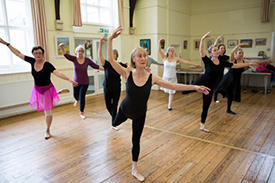 Across the UK, dance for older learners is on the rise. It is not simply dance that is the benefit for older dancers, but also the provision of challenges and the promotion of the ageing body through dance. Some participants may have prior experience of dance and some have none, however it is clear that many have discovered the benefits of dance, such as increased social opportunities, wellbeing and the chance to meet like-minded people.
Across the UK, dance for older learners is on the rise. It is not simply dance that is the benefit for older dancers, but also the provision of challenges and the promotion of the ageing body through dance. Some participants may have prior experience of dance and some have none, however it is clear that many have discovered the benefits of dance, such as increased social opportunities, wellbeing and the chance to meet like-minded people.
Renowned choreographers, such as Lea Anderson, Ben Duke and Charlotte Spencer, recently made new commissions for dance companies made up of older people, for example at the Elixir Festival at Sadler’s Wells. Other theatres are now also programming evenings of dance for and by older people, those who are striving to achieve more with both body and mind.
The older dance phenomenon, as it could be described, is not new. In London in 1989 Sadler’s Wells developed a resident, non-professional performance company for the over 60s, and Green Candle has featured work with older dancers as part of its core programme for 25 years. Despite this established industry sector, there is no denying that there is now a new interest in older dance, both by participants and audiences.
These trends are rolling out throughout the UK. The Royal Academy of Dance’s Silver Swans initiative – ballet classes across the country for over 55s – trains dance teachers in the ability to deliver suitable and safe classes for this age of dancer. LIFETIME took over The Point in Eastleigh to bring older dancers centre stage, programmed carefully like it would be for experienced artists. Four companies from across the south east performed, including Three Score Dance from Brighton and Dance SIX-0 from Salisbury.
Ultimately this work acknowledges and celebrates the growth of dance for older people. Work is still to be done though, in providing a wealth of opportunities and the chance to develop as an older dancer.
